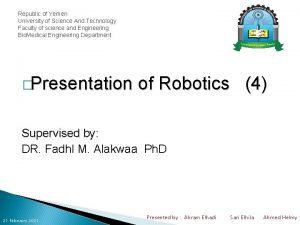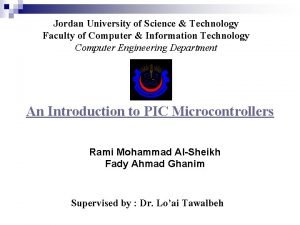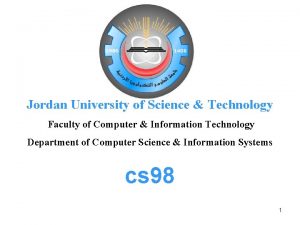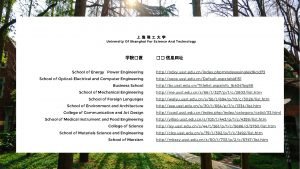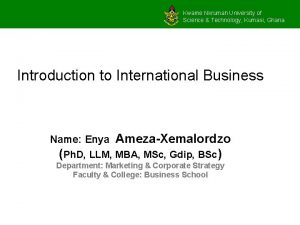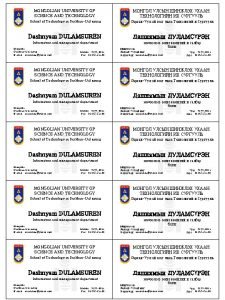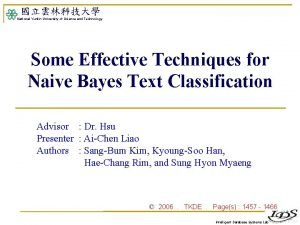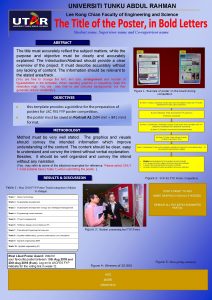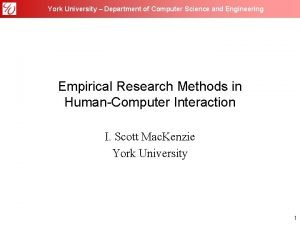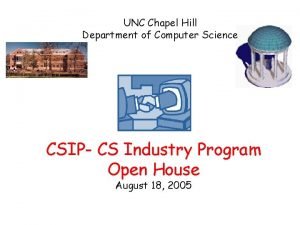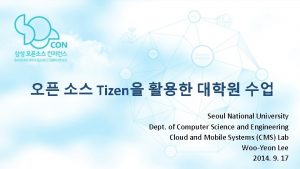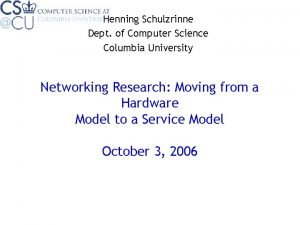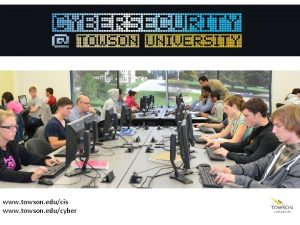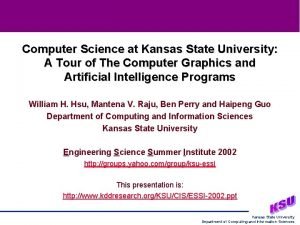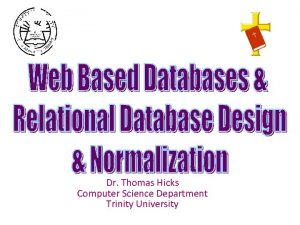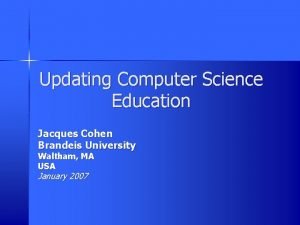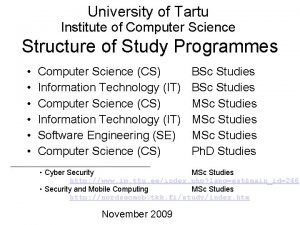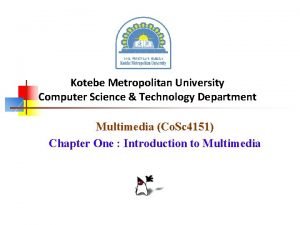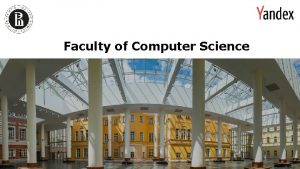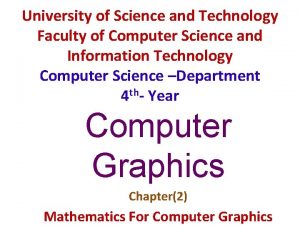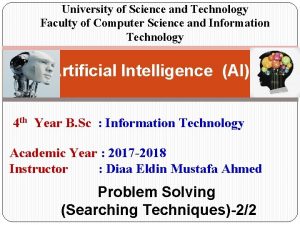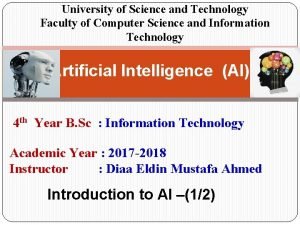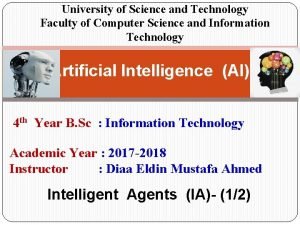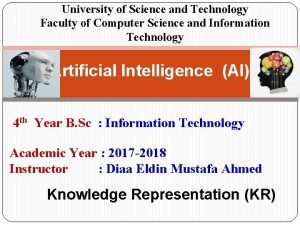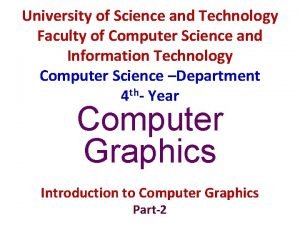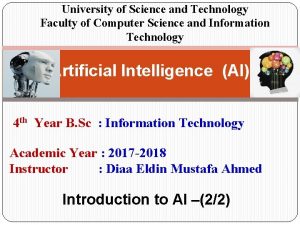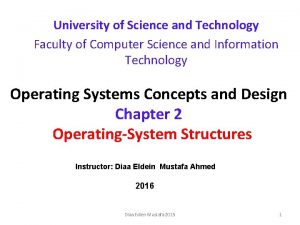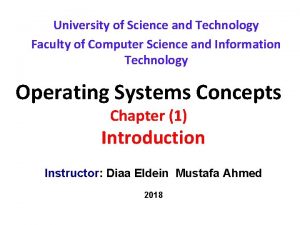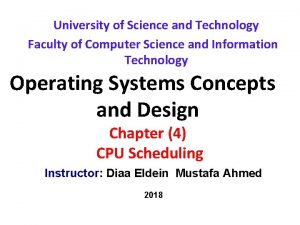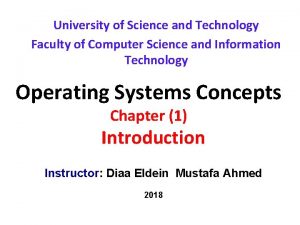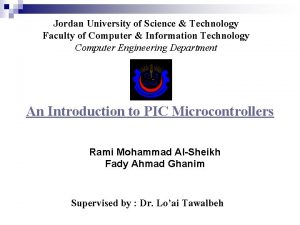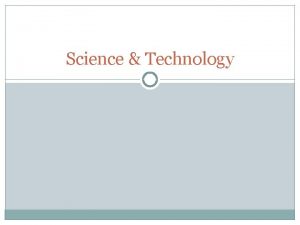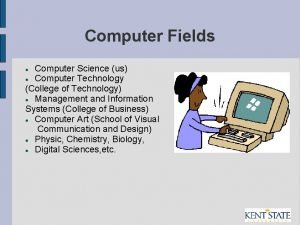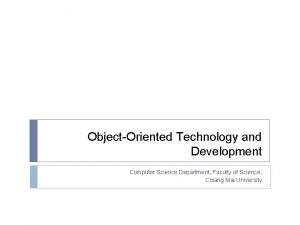University of Science and Technology Faculty of Computer







































- Slides: 39

University of Science and Technology Faculty of Computer Science and Information Technology Computer Science –Department 4 th- Year Computer Graphics Introduction to Computer Graphics Part-2

Basic Graphics System Input devices Output device Image formed in frame buffer Computer Graphics - Chapter (1) Diaa Eldein Mustafa Ahmed-2018 2

Raster-Scan Display Systems A simple raster system Computer Graphics - Chapter (1) Diaa Eldein Mustafa Ahmed-2018 3

• The Video Controller The most important task for the controller is the constant refresh of the display (60 frame per second) 1) Interlaced 1 st field: odd lines 2 nd field: even lines 2) Non-interlaced: updates every scan-line in every field 3) Output: RGB, monochrome, NTSC (video tape) 4) Sprites in animation: a sequence of fixed-size pixel maps. 5) Video Mixing: 6) FB + External Video --> VC --> display Computer Graphics - Chapter (1) Diaa Eldein Mustafa Ahmed-2015 4

Frame Buffer: memory that stores the color data for each pixel on the screen. Video controller reads the color value for each pixel and controls the intensity of the display at the pixel. Computer Graphics - Chapter (1) Diaa Eldein Mustafa Ahmed-2015 5

Memory Speed Problem: 1 K pixels / line 1 K lines / frame 60 frame / second 60 million reads/second ==>16 ns per read RAM speed ~ 50 ns/read ? Interlacing odd and even lines. VRAM: Video RAM (TI), reads all the pixels on a scan line in one cycle. Frame Buffer Depth Number of bits for each pixel (n). Also called number of planes. Number of possible colors: 2 n Computer Graphics - Chapter (1) Diaa Eldein Mustafa Ahmed-2015 6

• VRAM size >= screen resolution * depth 24 bits: 16 M colors, True Color Ø 1 K 1 K 3 bytes =3 MB VRAM Ø 1 K 768 3=2. 3 MB Ø 800 600 3=1. 5 MB Ø 640 480 3=1 MB 32 bits: RGBA, 16 M colors + Transparency (“Highest” in Windows) 16 bit: Pseudo True Color, 64 K (“Medium” in Windows) Ø 1 K 1 K 2=2 MB VRAM Ø 1 K 768 2=1. 5 MB Ø 800 600 2=1 MB Ø 640 480 2=0. 6 MB 8 bit: Indexed Color, 256, SVGA Ø 1 K 1 K 1=1 MB VRAM Ø 800 600 1=0. 5 MB Computer Graphics - Chapter (1) Diaa Eldein Mustafa Ahmed-2015 7

Look-up Table for Indexed Color(LUT) With indexed colors, pixel values represent the index number into the LUT. The corresponding data value in the LUT represent the colors. • 8 bits / pixel => 256 colors at a time. • 12 bit / entry => 4 k colors to chose the 256 from. Computer Graphics - Chapter (1) Diaa Eldein Mustafa Ahmed-2015 8

GPU (Graphics Processing Unit) • Specialized hardware to assist graphics display operations. (scan-convert, bitblt) • More to come on GPU and GPGPU. Computer Graphics - Chapter (1) Diaa Eldein Mustafa Ahmed-2015 9

Graphics Pipeline • Process objects one at a time in the order they are generated by the application • Pipeline architecture • All steps can be implemented in hardware on the graphics card display Computer Graphics - Chapter (1) Diaa Eldein Mustafa Ahmed-2015 10

Open. GL Architecture geometry pipeline Immediate Mode Polynomial Evaluator CPU Display List Per Vertex Operations & Primitive Assembly Rasterization Per Fragment Operations Frame Buffer Texture Memory Pixel Operations Computer Graphics - Chapter (1) Diaa Eldein Mustafa Ahmed-2015 11

Programmable Vertex and Pixel Processors 3 D Application or Game 3 D API Commands CPU 3 D API: Open. GL or Direct 3 D CPU – GPU Boundary GPU Command & Data Stream GPU Front End Assembled Polygons, Lines, and Points Vertex Index Stream Primitive Assembly Pre-transformed Vertices Pixel Location Stream GPU Rasterization & Interpolation Rasterized Transformed Pre-transformed Vertices Fragments Programmable Vertex Processor Pixel Updates Raster Operation s Framebuffer Transformed Fragments Programmable Fragment Processor An example of separate vertex processor and fragment processor in a programmable graphics pipeline Computer Graphics - Chapter (1) Diaa Eldein Mustafa Ahmed-2015 12

Graphics Display Hardware Raster (TV, bitmap, pixmap) used in displays and laser rinters Vector (calligraphic, stroke, random-scan) • Driven by display commands • (move (x, y), char(“A”) , line(x, y)…) Survives as “scalable vector graphics” Ideal Drawing Vector Drawing Computer Graphics - Chapter (1) Driven by array of pixels (no semantics, lowest form of representation) Note “jaggies” (aliasing errors) due to discrete sampling of continuous primitives Outline 13 Diaa Eldein Mustafa Ahmed-2015 Filled

Elements Of Pictures Created In computer Graphics • Polylines • Text • Filled regions • Raster Images Computer Graphics - Chapter (1) Diaa Eldein Mustafa Ahmed-2015 14

Polylines • A polyline is a connected sequence of straight lines • A curved line made up of straight-line segments. • Attributes of Lines and Polylines. Line Thickness Computer Graphics - Chapter (1) Diaa Eldein Mustafa Ahmed-2015 15

Text • Some graphics devices have two disitinct display modes. – Text mode (graphics device is divided into lines and columns (25 x 80) – Graphics mode (graphics device is divided into pixels( 480 x 640) at minimum based on the graphics card • A routine to draw a character string might Text Attributes look like draw. String(x, y, string) There are many text attributes, the most important of which are the test’s font , color, size, spacing, and orientation. Computer Graphics - Chapter (1) Diaa Eldein Mustafa Ahmed-2015 16

Filled-Regions • The filled-region primitive is d shape filled with some color or pattern. • Function • fill. Polygon (poly, pattern); Computer Graphics - Chapter (1) Diaa Eldein Mustafa Ahmed-2015 17

Raster Image • A raster Image is stored in a computer as an array of numerical values. • Hand-deisgned Images. • Computed Images. • Scanned Images. Computer Graphics - Chapter (1) Diaa Eldein Mustafa Ahmed-2015 18

Representation of Shades of gray and Color in Raster Images • Gray –scale Raster Images If there are only two pixel values in a raster image, it is called bi-level. An n-bit quantity has 2 n possible values, there can be 2 n gray levels in an image with pixel depth n. . The most common values are as follows : -Two bits per pixel produce 4 gray levels. -Four bits per pixel produce 16 gray levels. -Eight bits per pixel produce 256 gray levels. Computer Graphics - Chapter (1) Diaa Eldein Mustafa Ahmed-2015 19

Representation of Shades of gray and Color in Raster Images. • Color Raster Image Each pixel in a color image has a “color Value, ” a numerical value that somehow represents a color. Each value in the (red, green, blue) triple has a certain number of bits, and the color depth is the sum of these values. Computer Graphics - Chapter (1) Diaa Eldein Mustafa Ahmed-2015 20

Graphics Display Devices • Line-Drawing Display – – Creates pictures by drawing lines Pen plotter (Drawing with mechanical pens) Flatbed plotters Drum plotters • Vector displays cannot show smoothly-shaded regions or scanned images – (Cross-hatching) • Raster Displays – Create pictures by displaying dots – Other common displays produce hard copy of an image : Computer Graphics - Chapter (1) Diaa Eldein Mustafa Ahmed-2015 21

Graphics Display Devices the laser printer, dot matrix printer, ink-jet plotter, and film recorder. -. The built-in coordinate system for the surface of a raster display. -. The memory is frame buffer. -. The Scanning process -. Video Monitors(CRT) Computer Graphics - Chapter (1) Diaa Eldein Mustafa Ahmed-2015 22

Indexed Color and the Lookup Table • Each pixel stores an index into a color table. • Allows a large range of colors to be displayed using less memory for the image. (LUT is much less expensive. ) • The system has an 8 -bit-per-pixel frame buffer along with an LUT, and the LUT is 24 bits wide. The system can display 224 different colors, but only 256 at a time. • The bits per pixel determines the size of the color table. Computer Graphics - Chapter (1) Diaa Eldein Mustafa Ahmed-2015 23

Image Based Rendering • Appearance in available views is used to determine appearance in novel views • Rendering is faster

Computer Graphics - Chapter (1) Diaa Eldein Mustafa Ahmed-2015 25

Output Devices • There a range of output devices currently available: – Printers/plotters – Cathode ray tube displays – Plasma displays – LCD displays – 3 dimensional viewers – Virtual/augmented reality headsets • We will look briefly at some of the more common display devices Computer Graphics - Chapter (1) Diaa Eldein Mustafa Ahmed-2015 26

Basic Cathode Ray Tube (CRT) • Fire an electron beam at a phosphor coated screen Computer Graphics - Chapter (1) Diaa Eldein Mustafa Ahmed-2015 27

Raster Scan Systems • Draw one line at a time Computer Graphics - Chapter (1) Diaa Eldein Mustafa Ahmed-2015 28

Colour CRT • An electron gun for each colour – red, green and blue Computer Graphics - Chapter (1) Diaa Eldein Mustafa Ahmed-2015 29

Plasma-Panel Displays • Applying voltages to crossing pairs of conductors causes the gas (usually a mixture including neon) to break down into a glowing plasma of electrons and ions Computer Graphics - Chapter (1) Diaa Eldein Mustafa Ahmed-2015 30

Liquid Crystal Displays • Light passing through the liquid crystal is twisted so it gets through the polarizer • A voltage is applied using the crisscrossing conductors to stop the twisting and turn pixels off Computer Graphics - Chapter (1) Diaa Eldein Mustafa Ahmed-2015 31

Conceptual Framework for Interactive Graphics • Graphics library/package is intermediary between application and display hardware (Graphics System) • Application program maps application objects to views (images) of those objects by calling on graphics library. Application model may contain lots of non-graphical data (e. g. , non-geometric object properties) • User interaction results in modification of image and/or model • This hardware and software framework is 5 decades old but is still useful Software Application program Hardware Graphics Library Application Model / database Computer Graphics - Chapter (1) Graphics System/ GPU Diaa Eldein Mustafa Ahmed-2015 32

Graphics Library • Examples: Open. GL™, Direct. X™, Windows Presentation Foundation™ (WPF), Render. Man™, HTML 5 + Web. GL™ • Primitives (characters, lines, polygons, meshes, …) • Attributes – Color, line style, material properties for 3 D • Lights • Transformations • Immediate mode vs. retained mode – immediate mode: no stored representation, package holds only attribute state, and application must completely draw each frame – retained mode: library compiles and displays from scenegraph that it maintains, a complex DAG. It is a display-centered extract of the Application Model Computer Graphics - Chapter (1) Diaa Eldein Mustafa Ahmed-2015 33

Graphics Hardware Computer Graphics - Chapter (1) Diaa Eldein Mustafa Ahmed-2015 34

Primitives Computer Graphics - Chapter (1) Diaa Eldein Mustafa Ahmed-2015 35

Graphics Systems Computer Graphics - Chapter (1) Diaa Eldein Mustafa Ahmed-2015 36

Graphic Processor Unit (GPU) Computer Graphics - Chapter (1) Diaa Eldein Mustafa Ahmed-2015 37

Raster and Random Scan Computer Graphics - Chapter (1) Diaa Eldein Mustafa Ahmed-2015 38

Thank You End Questions ? Computer Graphics - Chapter (1) Diaa Eldein Mustafa Ahmed-2018 39
 Bridgeport engineering department
Bridgeport engineering department Bridgeport university computer science
Bridgeport university computer science Fsu computer science
Fsu computer science Brown university computer science
Brown university computer science Ucl computer science faculty
Ucl computer science faculty Hanoi university of science and technology vietnam
Hanoi university of science and technology vietnam Spike unist
Spike unist Science technology university yemen
Science technology university yemen Jordan university of science and technology
Jordan university of science and technology Jordan university of science and technology
Jordan university of science and technology Jordan university of science and technology
Jordan university of science and technology University of shanghai for science and technology
University of shanghai for science and technology Hamzeh khanpour
Hamzeh khanpour Pingtung university of science and technology
Pingtung university of science and technology University of science and technology kumasi
University of science and technology kumasi Mongolian university of science and technology logo
Mongolian university of science and technology logo National yunlin university of science and technology
National yunlin university of science and technology Wwwk-6.thinkcentral
Wwwk-6.thinkcentral Faculty of business and economics mendel university in brno
Faculty of business and economics mendel university in brno University of debrecen faculty of economics and business
University of debrecen faculty of economics and business Faculty of business and economics mendel university in brno
Faculty of business and economics mendel university in brno Lee kong chian faculty of engineering and science
Lee kong chian faculty of engineering and science Lee kong chian faculty of engineering and science
Lee kong chian faculty of engineering and science Hijjawi faculty for engineering technology
Hijjawi faculty for engineering technology My favorite subject is english because
My favorite subject is english because University of phoenix computer science
University of phoenix computer science Yonsei syllabus
Yonsei syllabus York university computer science
York university computer science University of north carolina chapel hill computer science
University of north carolina chapel hill computer science Seoul national university computer science
Seoul national university computer science Osaka university computer science
Osaka university computer science Computer science columbia university
Computer science columbia university 7800 york road
7800 york road Kansas state university computer science
Kansas state university computer science Trinity university computer science
Trinity university computer science Brandeis university cs
Brandeis university cs University
University Kotebe metropolitan university departments list
Kotebe metropolitan university departments list Webnis
Webnis Herszon kherson maritime college of merchant marine fleet
Herszon kherson maritime college of merchant marine fleet







